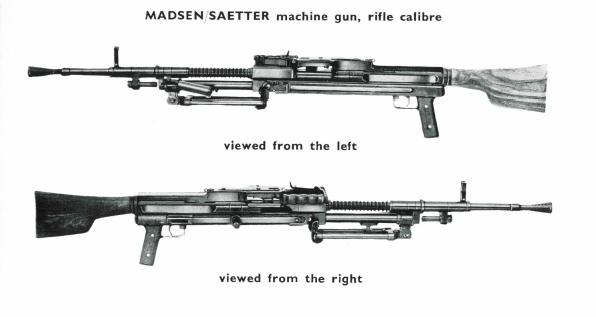 Unfortunately, the Danish firm Madsen had a hard time getting many of its firearms to be widely accepted. The most successful was the early LMG, and also the M50 submachine gun. But many Madsen designs were just too late to catch the market. The Madsen-Saetter GMPG is one such design. It was a quite functional gun, air cooled, QB barrel, and feeding from non-disintegrating metal inks in 50-round sections. It just couldn’t offer enough advantage over other contemporary designs to make many sales. If you would like to resurrect one, though, you may find the original manual helpful:
Unfortunately, the Danish firm Madsen had a hard time getting many of its firearms to be widely accepted. The most successful was the early LMG, and also the M50 submachine gun. But many Madsen designs were just too late to catch the market. The Madsen-Saetter GMPG is one such design. It was a quite functional gun, air cooled, QB barrel, and feeding from non-disintegrating metal inks in 50-round sections. It just couldn’t offer enough advantage over other contemporary designs to make many sales. If you would like to resurrect one, though, you may find the original manual helpful:
Madsen Saetter GPMG manual (English)

very interesting website, madsen produce rare firearms like colombian M47 light rifle, i hope you post this manuals if you find one, madsen produce this bolt action firearm in the WWII postwar, when other manufacturers to offer semi or full auto rifles for military purposes.
Looking for a full military stock set for a Madsen model 47 I have an as new barreled action that someone tried to customize the stock. What a shame. PLEASE can you help me???
Delford Walthall
This is not related to the current topic, but I wanted to share my reflections on the way of mounting the magazines. madsen (perhaps the first to do so) had a top-mounted magazine. I wil not vouch for the accuracy of this information, but I think I came across the supposition that this was with its aearial use in mind (making it easier to shoot downwards from an ircraft). So could be explained the position of teh magazine(s) on the Fiat-Revelli (basically – machine pistol, because it was firing pistol rounds) used originally on the aircraft.
Then came side-wise mounted magazine of Schmeisser (after it god rid of its original drum magazine of the Borgchardt-Parabellum pistol), the shape easier for trench warfare and firing it from the trenches in teh standing position. This was copied later in the British Lanchester and STEN (where the instruction manual warned – I did not read that myself – against holding the weapon by the magazine while shooting, which was likely to produce jamming of the weapon – somethign the members of the Polish underground during the Second World War often complained about. Thet shape of magazine also produced shifting the center of gravity in the course fo firing. The Box magazine maounted vertically udner the weapon did not have this disadvantage.
Regards, Andrze